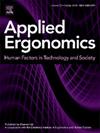Extent of teleworking and work Stress: The role of information and communication technology and job-related demands and resources
IF 3.4
2区 工程技术
Q2 ENGINEERING, INDUSTRIAL
引用次数: 0
Abstract
With over 41 million hybrid and high-extent teleworkers in Europe, the landscape of remote work has drastically transformed. Considering the teleworking extent, this study explores the relationships between information and communication technology (ICT) demands, ICT resources, social resources, job demands, and work stress among 1495 Estonian full-time employees engaged in telework and regular ICT use. Hybrid teleworkers reported higher work stress and ICT demands than high-extent teleworkers. In both groups, high e-communication demands, work requiring concentration, and email challenges were associated with increased work stress. Conversely, job resources such as concentration-enabling workplaces, information sharing and collaboration reduced stress. Hybrid teleworkers experienced elevated stress from ICT difficulties, while high-extent teleworkers were more affected by relationship maintenance. Feeling appreciated was related to lower stress for high-extent teleworkers. Moderation analysis revealed that collaboration and information sharing buffered stress from excessive e-communication only for hybrid teleworkers. Findings offer insights for improving telework practices.
远程工作的程度和工作压力:信息和通信技术和工作相关的需求和资源的作用
欧洲有超过4100万混合远程工作者和高度远程工作者,远程工作的格局发生了巨大变化。考虑到远程办公的程度,本研究探讨了爱沙尼亚1495名从事远程办公和定期使用ICT的全职员工的信息通信技术(ICT)需求、ICT资源、社会资源、工作需求和工作压力之间的关系。混合型远程工作者报告的工作压力和ICT需求高于高度远程工作者。在这两组中,高电子通信需求、需要集中注意力的工作和电子邮件挑战都与工作压力增加有关。相反,工作资源,如能够集中注意力的工作场所、信息共享和协作,可以减轻压力。混合型远程工作者的信息通信困难压力较高,而高度远程工作者的关系维护压力更大。高度远程工作者感到被欣赏与压力降低有关。适度分析显示,协作和信息共享仅对混合型远程工作者缓冲了过度电子通信带来的压力。研究结果为改进远程办公实践提供了见解。
本文章由计算机程序翻译,如有差异,请以英文原文为准。
求助全文
约1分钟内获得全文
求助全文
来源期刊

Applied Ergonomics
工程技术-工程:工业
CiteScore
7.50
自引率
9.40%
发文量
248
审稿时长
53 days
期刊介绍:
Applied Ergonomics is aimed at ergonomists and all those interested in applying ergonomics/human factors in the design, planning and management of technical and social systems at work or leisure. Readership is truly international with subscribers in over 50 countries. Professionals for whom Applied Ergonomics is of interest include: ergonomists, designers, industrial engineers, health and safety specialists, systems engineers, design engineers, organizational psychologists, occupational health specialists and human-computer interaction specialists.
 求助内容:
求助内容: 应助结果提醒方式:
应助结果提醒方式:


